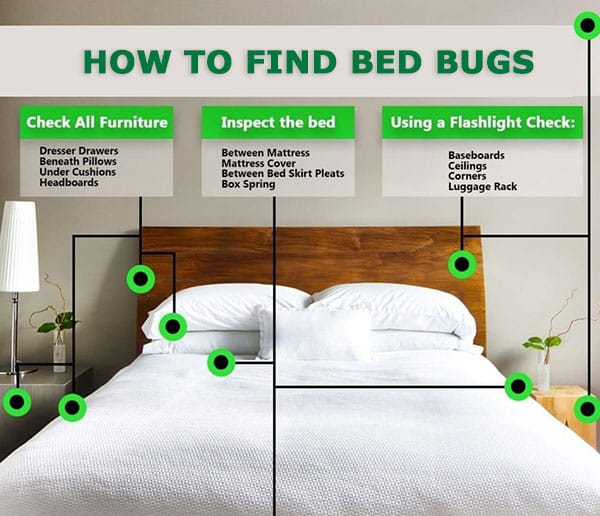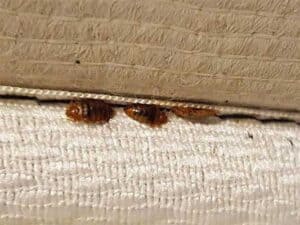Bed bugs are easily the most horrible insects homeowners can have in their homes. They cause significant distress and discomfort. When the bed bugs bite, they irritate some individuals and result in a restless night of sleep. Parents with toddlers become extremely weary as the bugs bite their toddlers, causing soreness. Infants have a weaker immune system, and some find that they develop secondary allergies. As people begin the process of locating bed bugs, most folks can start with a good idea of at least one room that they are residing in.
Bed bugs are intelligent insects and mainly have the instinct to bite at night. You will hardly spot a bed bug in the day unless it’s starving and has been a long time since the last blood meal. When the host is asleep, they sneakily come out at night, feast on the blood and go back to their dark quarters. You can detect them in a room of a sleeping person by switching off the lights. You may find one or a few crawling on the mattress, as they reach for the blood of a sleeping person.
It is also easy to spot them in corners and nooks of the mattress, seams, cracks in furniture or loose wallpaper. There are various other ways to find the traces when you can’t spot a bug with the naked eye during the day. To understand the nature of the infestation, however, it is essential to learn this bug’s life cycle, habitat, and preferences.
Understanding the Life Cycle of a Bed Bug
It is a tiny species from the genus Cimex. They primarily feed on the blood of humans and other warm-blooded animals, including cats, dogs, birds, rodents, etc. Their mouth ends in a straw-like shape and doesn’t have teeth. It is the reason why they thrive on feeding on blood only. They enter homes undetected traveling in clothes, furniture, luggage or bags.
The way bed bugs thrive and reproduce helps develop an understanding of their pattern. Knowing their patterns also helps in devising a strategy to end the infestation. Bed bugs have six stages of life. First, they require at least one blood meal to move on to the next stage. Then, as they grow, they shed the shell. It is easy to detect these shells on the infestation site.
They mate and produce eggs after a meal. Both male and female bed bugs require one blood meal in fifteen days. A female bed bug lays approximately one to three eggs a day. And in her complete life span, which is somewhere between six months or a year, lays from 200-500 eggs. Sometimes, growth regulators don’t reach all eggs during the extermination. Hence there is a chance of the next round of infestation. But to be safe, another round of extermination is advised within a month to kill the newly hatched nymphs before creating havoc.
How Does a Bed Bug Bite?
Blood is the only source of survival for these insects. They wait for the host to sleep and then start piercing the skin to find a suitable blood vessel. To find the right blood vessel, they may puncture various spots. The bite may appear different for everyone. This variation may be due to the process of biting. Even people sleeping next to each other may find the spots appear differently.
When bed bugs bite, they inject an anticoagulant into the host’s skin with their saliva. How a person’s skin reacts to anticoagulants can vary from person to person. It also determines the size of the rash or welt on the host. If the sleeping person moves, the bug stops mid-way to ensure the discomfort doesn’t wake the host. Then once the movement stops, it continues to feed on the blood. This behavior is why bed bug bites appear in lines, a cluster of a zig-zag pattern. A fully fed bed bug then heads back to its hiding quarters and appears slightly fuller and red.
Why Is It Hard to Find Bed Bugs?
Bed bugs are incredibly tiny, with a flat body and the size of flaxseed. Their slim body allows them to infest dark and hard-to-reach corners of rooms, items, clothing, furniture and mattresses. They are not typically visible in the day and mainly appear at night when they detect the slow heartbeat of a sleeping person. Their sneaky and clever ways make it extremely hard to find them crawling around like other insects during the day.
Where to Find Bed Bugs
When searching for bed bugs, look for old shells and fecal matter. The brown fecal matter will appear like stains on the mattress when smeared. It is a classic sign of bed bug infestation. They are most likely hiding in cervices and cracks. Usually, the areas to look at are box springs, headboards, bed frames, and the seam of the mattress. They spread to other furniture and room fixtures as they grow in number.
They also move to other rooms in the house. When looking in places other than the bed, look around door frames, the seam of sofa or cushions, folds and seams of curtains, behind loose wallpaper and even on the head of the screws.
Signs of Infestation
Used furniture, public transport or motels are high sources for bed bug hitchhikers. Knowing the signs of bed bug infestations is essential to avoid staying in bed bug hotels or taking in used furniture. Take a few minutes to go through the below list to find bed bugs when you’re traveling to avoid infestations.
Having unexplained bites can be very discouraging. Bed bug bites show up in groups or clusters. They appear as red welts and will usually on the arms, shoulders, neck and face. Exposed skin and areas close to the mouth are commonly bitten since that is where carbon dioxide is expelled. Carbon dioxide is what bed bugs use to find a blood meal. Not every bite or reaction to a bite looks the same. At this time bed bugs don’t spread diseases that are known but a lot people will have reactions to them including rashes, hives or blisters. We always recommend consulting with your physician if you think you have been bitten.
Besides the itchy arm with bites, other signs a room is filled with bed bug crawlers can be:
- Inspect the mattress you were sleeping on. Check the pillowcases, seams and underneath to look for reddish colored stains. The smears and stains are from crushing them as you rollover in your sleep. You may also see brownish coloring. This would be the fecal matter that can stain the mattress as well. If you see staining and you have been bitten, it is safe to say you have a bed bug infestation.
- Above we introduced the unpleasant thought of bed bug fecal matter. We recommend you check the seams of the mattress and be aware that they will leave brownish stains in other areas. Picture frames, dressers, headboards and other furniture. Bed bugs will hide in all the small cracks and crevices throughout a room. Clean out all the drawers and be sure not to take clothing or other articles to other areas to avoid spreading the issue.
- Bed bug eggs and empty shells may need some close inspection to identify. A magnifying glass may be helpful in locating these items. After hatching bed bugs will leave the egg casing and they also shed their exoskeleton when the young (nymph) bed bugs mature. They will do this 5 times as they move through the complete life cycle and this can leave a lot of excess byproduct (shredded skin) around the areas of infestation.
- Bed bugs have a musty odor. Their smell can be noticed instantly walking into rooms with bed bug infestations. If one can identify this odor, it can help by avoiding dingy or moldy hotel rooms.
- As soon as you see these signs, ensure you wash the clothes and belongings thoroughly to avoid bringing these into your homes.
- Developing itch after buying a particular used bed set or mattress.
Why Killing Bed Bugs is a Difficult and Frustrating Process
It takes time and perseverance to kill all the bed bugs in your home. That’s why you need to understand their habitat and behaviors – so you can completely get rid of them all. Infestations increase quickly. Less than ten bed bugs can produce colonies of new ones within weeks.
- When exterminating the bugs, you must wash all clothes, linen, towels and sometimes curtains with hot water. It is the only way to ensure that any bed bugs are left alive. They die from hot water, detergent and the high heat from a dryer.
- You can air-dry clothes in the sun, heat the clothing in sealed garbage bags or run a dryer for 15-30 minutes on high heat.
- Soft toys, shoes and toys that cannot be machine washed should be sterilized in the dryer for at least fifteen minutes, or you can wipe everything down with Clorox wipes or running alcohol.
- A professional bed bug exterminator may need to flip all the furniture meticulously and spray on the back of furniture, cupboards, etc. Be prepared to have furniture moved.
- The mattress would require extra attention, ensuring insecticides, steam or heat reach all seams and folds.
- You can find bed bugs in racks on floorboards, walls, crevices around switchboards, door frames or loose wallpaper – everything needs spraying or treated meticulously.
- It is best to brush all the sites of infestation and vacuum. After brushing, you must vacuum all the nooks and corners, ensuring you catch all the eggs.
- As soon as you finish vacuuming, place the vacuum bag immediately in a plastic bag. After tying the plastic bag tightly, throw it in a trash can outside the home. If you have a bag-less vacuum, please rinse and clean all parts shortly afterward.
Finding Bed Bugs Again?
Many homeowners will find themselves repeating the bed bug control processes without ever getting rid of bed bugs. Even after a painstaking effort, bed bugs can quickly return. And that makes one start the whole process all over again as well as the headaches.
Throw Out Bed Bug Infested Furniture?
This re-infestation of bed bugs can happen with all types of furniture, but we see beds as the main complaint. Often, the infestation reaches a certain point, many homeowners throw out the mattress, headboard and box spring. But before you get a new mattress, ensure there are no bugs because they start infesting the new bed in no time.
Another great tip is to wrap your mattress in a tight zip mattress cover. A bed bug can survive without a blood meal, but it dies after a year. If you wrap your mattress for a year, it is a sure way to ensure they die. If you go the chemical route, it is essential to know that the chemical or insecticide is safe to use on linen and mattresses. Moreover, the fumes of store-bought chemicals or insecticides linger even after days, and that can cause allergies and breathing problems.
Hence, it is best to hire professionals who use the right chemicals around the house. Also, they are more thorough due to their experience and we will never ask you to throw out furniture which can save you $1,000’s of dollars. We have all the tools to clean and check the nooks and crooks around the house to ensure the extermination is successful.
Rule Out Medical Conditions
Most of the time, people are unaware of the infestation and mistake them for mosquito or spider bites. Shells and stains on bedding, however, can confirm otherwise.
Each person reacts differently to the bed bug bites meaning they can look different on different people. For some, these bites go unnoticed, while other individuals develop itching, swelling, or red welts. Mostly they appear on the exposed parts of the skin and can cause discomfort. Sometimes, these bites can cause a burning sensation and develop bumps. These red bumps are known as wheals or papules. Often these rashes can swell dramatically and cause inflammation.
Even with the slightest signs of discomfort, contact the health care provider immediately. They can usually rule out any medical conditions and identify bed bug bites. It’s important to note that elderly and infants have a weaker immune system, they may develop secondary infections from continuous swelling and itching. Watch out for the signs of discomfort, changing colors or swelling on the host’s skin.
Only Common Pest Bites in Groups at Night
Bed bugs bite in groups or clusters at night. Some other pests like chiggers, fleas, fire ants, bird mites, rat mites and head lice may follow the same pattern but not often are these pests doing most of their biting at night.
Bed bugs are nocturnal since humans or other hosts are sleeping at night. It makes it easy to feast on the blood and crawl back unnoticed as the host sleeps. When looking for a perfect spot for the blood meal, they puncture a few holes in the skin. In each puncture, they inject anticoagulants. After finding the spot perfect for a blood meal, they stay in the area for three to ten minutes and then head to the cracks and seams.
Best Practices After Extermination
Here are some expert suggested practices after getting professional extermination from bed bugs.
- Invest in buying metal furniture. Bed bugs thrive in warm places; hence wood is always a welcome place for these bugs.
- When buying second-hand furniture, check for all the signs of infestations.
- Use a light color protective cover for the mattress and box spring. It eliminates the hiding spots, and light color makes it easy to spot a bed bug.
- Vacuuming your home frequently detects and removes any uninvited intruders.
- Seal all the crevices and cracks around the house.
- Glue the loose wallpapers.
- Minimalistic spaces make it very difficult when trying to figure out how to find bed bugs.
How To Find Bed Bugs
We all know what a nuisance bed bugs can become. They multiply fast within a few days, invade from one room to another and travel. Imagine you bring a couple of bugs to your friend’s house – it’s highly likely that they will grow into a large infestation in no time in the new home. It is distressing for everyone and requires time and energy to kill the entire nest.
Look for professional services as they have complete knowledge of eradicating the bug. EnviroPest is focused on eliminating bed bugs from your homes for your family. With our Steam and Treat processes, homeowners have trusted us for over 30 years. Our highly professional and trained staff have a minimum of experience of over ten years as bed bug specialists. This experience is just one more reason to trust the bed bug pros at EnviroPest as the bed bug exterminator for your home and family.




